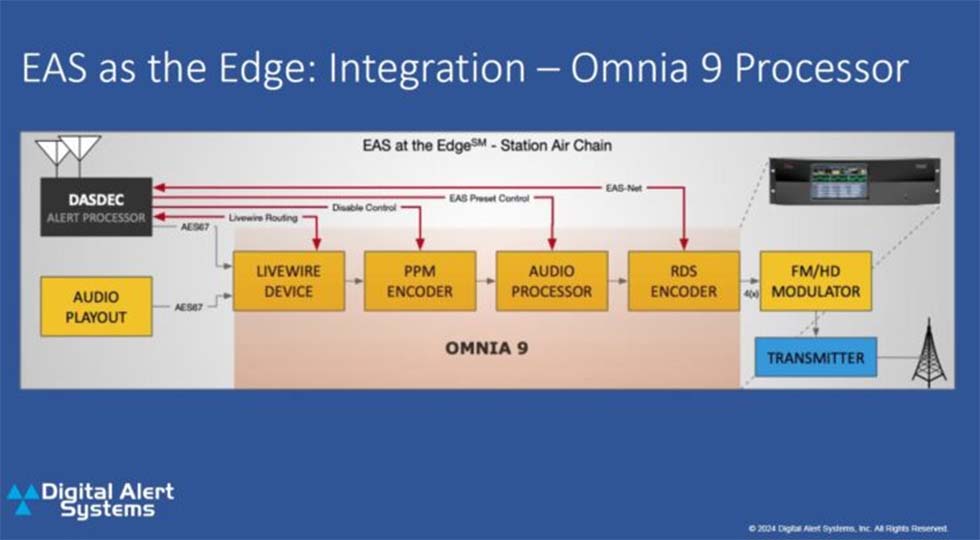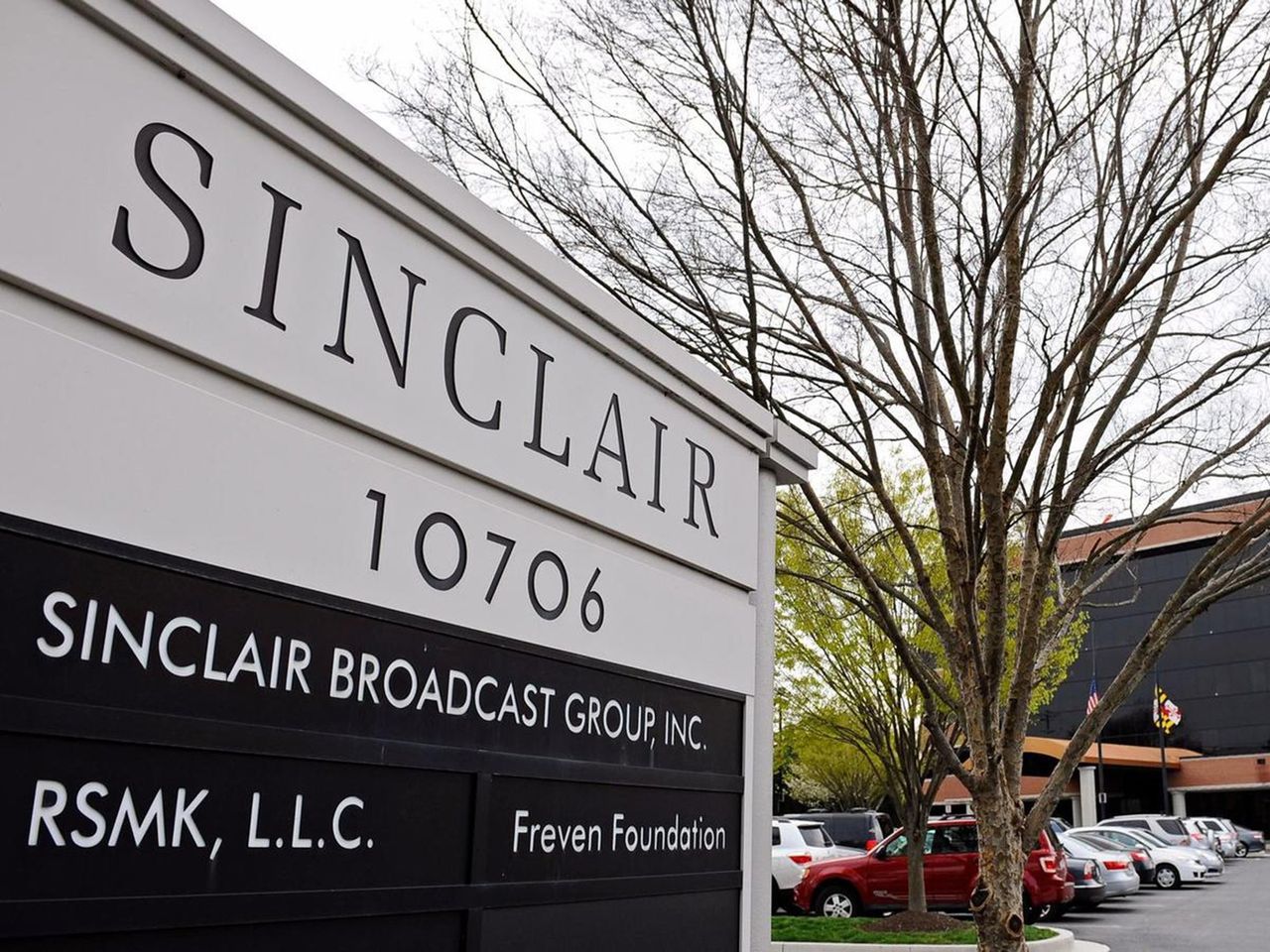FCC Hears About ‘EAS at the Edge’
Three technology companies discussed their concept with commission staff

If the FCC is going to allow radio broadcasters to adopt software-based EAS infrastructure, it should weigh the challenges of virtualization and consider how potential solutions might work together to meet them within the current regulatory framework.
That was the message from representatives of Digital Alert Systems, Telos Alliance and Nautel, who met in a video conference in October with nine staff members of the commission’s Public Safety and Homeland Security Bureau.
What follows is a summary of the presentation, submitted to the FCC as an ex parte filing. It was written by Edward Czarnecki, vice president, global and government affairs for Digital Alert Systems and has been edited for space.
You can view slides that accompanied this presentation here.
The purpose of the meeting was to provide the FCC with a full understanding of a solution supporting EAS in audio-over-IP (AoIP) and virtualized environments currently deployed at several broadcast radio stations. …
The meeting began with an overview of issues faced by various radio stations adopting audio-over-IP and virtual architectures that do not readily integrate with certain legacy approaches.
The three companies meeting with the FCC combined their resources to craft an approach to address the AoIP and virtualization challenge for EAS. We also noted that many radio participants may not be aware of similar integrations already accomplished within the video services sectors — cable, IPTV, and broadcast TV—over the past decade to support EAS in IP and virtual environments.
While noting that virtualization brings new possibilities that might provide cost savings and new types of functionalities, we outlined various limitations of virtualization — as acknowledged by industry experts — that some forms of virtualization can be problematic considering a range of regulatory, policy, security and operational factors.
We explained how some of the broadcast industry’s leading manufacturers have collaborated to develop and field a solution to enable EAS in a virtualized environment. This approach — called “EAS-at-the-Edge” — involves a hybrid combination of the EAS device at the operator site, virtualized systems for radio station operations and virtualized services for system monitoring, management, reporting and software updating.
Conventional EAS processing at a radio station essentially consists of switching baseband audio, which is insufficient for the IP requirements of an AoIP or virtualized system. In the hybrid virtualized EAS-at-the-Edge environment, the DASDEC addresses this obstacle by communicating via IP (AES-67 plus routing/control protocols) to enable EAS insertion into the modern AoIP air chain. Hybrid virtualization combines IP-enabled EAS appliance and software virtualization to simplify EAS from reception to playback.
As discussed during the meeting, this approach yields an elegant architecture by essentially reducing the radio station footprint to two devices. With this currently deployable architecture, our hope is this approach simplifies issues for broadcasters in terms of cost, complexity and FCC compliance.

We illustrated how virtualized radio station solutions already provided by Telos Alliance (the Omnia.9) and Nautel (the GV2) were able to fully interface with the DASDEC EAS system, using a combination of Livewire for AoIP support and EAS-net for additional signaling functions. We showed how, as in the case of Nautel, this combination of resources reduces virtualized broadcast station to an elegant two-unit approach — the DASDEC for comprehensive emergency alert management plus the GV2 to accommodate every function from audio playout, PPM encoding, audio processing, RDS encoding, FM/HD modulation and transmission.
Our joint stance is that the hybrid virtual approach would be secure and afford a greater deal of resilience in the broadcast architecture. In response to questions from the FCC regarding scenarios of internet unavailability and system survivability, we provided detailed responses stressing the flexibility and survivability of this architecture. The example of one client was provided, where they intend to run processing and insertion at the network operations center (NOC) but are also implementing redundancy at the edge (the transmission points) if contact with the NOC was lost.
Simplified station architectures were examined via two leading virtual air chains (the examples of the Telos Omnia.9 and Nautel GV2). One objective of this approach is to provide autonomous continuity of operations at the local station or local transmission site. Regardless of a particular air chain configuration, there would be survivability and ability to inject the EAS message into the transmitter regardless of disruption in other areas of the air chain.
A range of security considerations were discussed, including a broadcast station’s overall security posture and component-level security. We addressed questions from the FCC participants around security at a radio station’s studio and transmitter, and between the studio and the transmitter.
We illustrated how virtualized radio station solutions already provided by Telos Alliance (the Omnia.9) and Nautel (the GV2) were able to fully interface with the DASDEC EAS system, using a combination of Livewire for AoIP support and EAS-net for additional signaling functions. We showed how, as in the case of Nautel, this combination of resources reduces virtualized broadcast station to an elegant two-unit approach—the DASDEC for comprehensive emergency alert management plus the GV2 to accommodate every function from audio playout, PPM encoding, audio processing, RDS encoding, FM/HD modulation and transmission.
Our joint stance is that the hybrid virtual approach would be secure and afford a greater deal of resilience in the broadcast architecture. In response to questions from the FCC regarding scenarios of internet unavailability and system survivability, we provided detailed responses stressing the flexibility and survivability of this architecture. The example of one client was provided, where they intend to run processing and insertion at the network operations center (NOC) but are also implementing redundancy at the edge (the transmission points) if contact with the NOC was lost.
Simplified station architectures were examined via two leading virtual air chains (the examples of the Telos Omnia.9 and Nautel GV2). One objective of this approach is to provide autonomous continuity of operations at the local station or local transmission site. Regardless of a particular air chain configuration, there would be survivability and ability to inject the EAS message into the transmitter regardless of disruption in other areas of the air chain.
A range of security considerations were discussed, including a broadcast station’s overall security posture and component-level security. We addressed questions from the FCC participants around security at a radio station’s studio and transmitter, and between the studio and the transmitter.
The meeting highlighted how this particular approach enables EAS in virtual and AoIP air chains, with full compliance with existing regulatory and operational requirements, including FCC Part 11 and Part 15 rules, government equipment type approval, and FEMA IPAWS conformity testing.
Our strong recommendation was that no solution should be contemplated by an EAS participant or the government without fully meeting those existing interagency requirements.
It was noted that this approach has already received significant industry recognition, including the 2024 Technology Award from the Society of Broadcast Engineers, and a Radio World “Best of Show” Award at the 2024 NAB Show.
We observed that, as published in trade press and stated by FEMA officials, FEMA IPAWS prefers “full compliance with FCC rules” and has stated “IPAWS does not endorse any specific product but enthusiastically welcomes discussion about innovative solutions that can enhance the timely and effective distribution of alerts to the public.”
Virtualized EAS device administration was presented in the form of Digital Alert Systems’ HALO system that monitors and manages all EAS devices in an enterprise environment. With fully virtualized EAS device administration, HALO provides remote enterprise monitoring, health status and configuration management of EAS devices, with provisions for remote delivery of software updates and security patches.
Currently deployed at major broadcast and cable TV operations, HALO can also provide the remote monitoring, management and updating capabilities being sought by the broadcast radio industry. In response to a question from the FCC regarding virtualized EAS software and HALO, we clarified that HALO remote enterprise management applies to EAS in either a physical or virtual (VM) environment.
Regarding accessibility, we detailed information on how we have utilized this EAS-at-the-Edge to successfully broadcast visual alerts in HD Radio, incorporating symbology to visually indicate the presence and type of alerts on enabled radio receivers. We suggested this approach would further the commission’s objectives of making emergency alerts more accessible including to those with limited English proficiency. Responding to FCC questions, we clarified that the symbology was included in the HD Radio data (program art) transmission sent from the station and received on conventional HD Radio receivers.
Whether via symbology in HD Radio, or RDS, our approach can enable persistence in the display of alerts during the active time of an emergency event, even after the EAS message itself has been played. This approach is compatible with millions of HD Radios currently used in the U.S. today, without any change required by the consumer or HD Radio manufacturer.
Concluding the meeting, we recapped how this industry-proven approach yields reduced security and operational risks while maintaining regulatory and operational compliance. This standards-based approach combines simplicity, reliability and high availability in an architecture that is being deployed today.
We also noted our hope for continued discussion between industry participants, hopefully leading to a consensus on optimal paths forward given operational, regulatory, and technical realities. …
Digital Alert Systems, Nautel and Telos Alliance thank the commission for its efforts to maintain a resilient and secure national Emergency Alert System. Our companies are mutually committed to the development and deployment of broadcast systems that will achieve the objectives of a secure, reliable and robust public warning architecture in ways that will be compliant with government requirements.
[Related: “NAB Differs With EAS at the Edge in Important Respects” ]
This article initially appeared in TV Tech sister brand Radio World.
Get the TV Tech Newsletter
The professional video industry's #1 source for news, trends and product and tech information. Sign up below.
